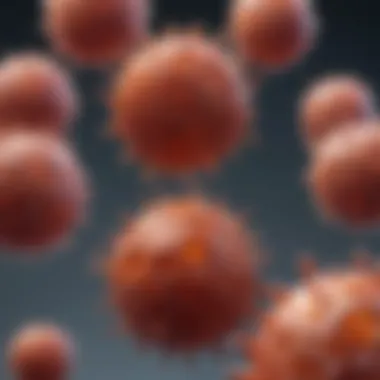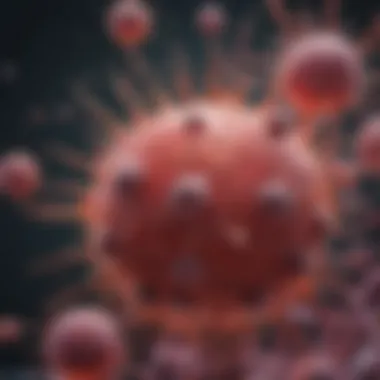Eosinophils in Immunity: Functions and Insights


Intro
Eosinophils are specialized white blood cells that play a significant role in the immune response. Their presence in the body is crucial for defending against certain pathogens, particularly parasites, and in mediating allergic reactions. Understanding eosinophils' functionality is paramount for gaining insights into various health conditions.
This article investigates the multifaceted functions of eosinophils. It begins by discussing their role in normal immunity and progresses to explore their implications in diseases such as asthma, eosinophilic esophagitis, and chronic rhinosinusitis.
Research Overview
Summary of Key Findings
Recent studies highlight several key roles of eosinophils. These include:
- Defense against parasites: Eosinophils are primarily activated during parasitic infections, where they target and destroy pathogens through degranulation and secretion of cytotoxic proteins.
- Allergic responses: Eosinophils significantly contribute to hyperreactivity and inflammation, often observed in allergic diseases.
- Tissue repair: Emerging research indicates that eosinophils may assist in tissue healing following injury, broadening the understanding of their physiological roles.
Importance of the Research
The research surrounding eosinophils carries substantial clinical relevance. As eosinophils are involved in various pathologies, understanding their mechanisms can lead to better diagnostic tools and therapeutic strategies. Improved knowledge can also aid in identifying eosinophil-related diseases earlier, thus allowing for timely intervention.
Methodology
Study Design
The investigation into eosinophils typically employs a multi-faceted approach. Various methodologies are used, including observational studies, cellular assays, and animal models to assess eosinophil function in diverse settings.
Data Collection Techniques
Data collection surrounding eosinophil activity often involves:
- Blood sampling: Analyzing eosinophil counts through blood tests can provide insights into their systemic involvement in diseases.
- Biopsy samples: Tissue biopsies enable researchers to study the localized eosinophil activity and their role in specific conditions.
- Flow cytometry: This technique is crucial for understanding the activation states and functions of eosinophils at the cellular level.
Understanding the nuanced involvement of eosinophils in health and disease is critical for developing targeted therapies.
This exploration into eosinophils aims to provide readers with a comprehensive understanding of their roles within the immune system and their broader implications for health. By analyzing current research, the article seeks to enhance awareness of the significance of these cells in both clinical and physiological contexts.
Preface to Eosinophils
Eosinophils are a distinct group of white blood cells that play pivotal roles in the immune response. Their functions extend beyond merely being a part of the immune system; they are essential in various physiological processes and pathological conditions. Understanding eosinophils holds significant importance for researchers and health professionals alike. This section lays the groundwork for comprehending their role in immunology, offering insights into their characteristics, historical context, and importance in health and disease.
Definition and Characteristics
Eosinophils are a type of granulocyte characterized by their unique granules that stain with eosin, a red dye. They are produced in the bone marrow and are primarily found in peripheral blood and tissues.
Key Characteristics of Eosinophils:
- Size: Eosinophils generally range from 12 to 17 micrometers in diameter.
- Nucleus: They possess a bilobed nucleus, which differentiates them from other leukocytes.
- Granules: The cytoplasm contains large granules filled with proteins and enzymes such as major basic protein, eosinophil peroxidase, and eosinophil cationic protein. These granules play a crucial role in the elimination of pathogens and modulation of immune responses.
Functionally, eosinophils are notably involved in combating parasitic infections, regulating allergic reactions, and participating in inflammatory responses. Their activity is tightly regulated by various signaling molecules and cytokines, which guide their differentiation and activation.
Historical Perspective
The discovery of eosinophils dates back to the late 19th century. They were first identified by Paul Ehrlich in the 1870s when he noted the unique staining properties of these cells. This period marked the beginning of recognizing eosinophils as important components of the immune system.
Over time, further research has led to a greater understanding of their role in various diseases. Initially thought to primarily respond to parasitic infections, eosinophils are now appreciated for their involvement in allergic conditions, asthmatic responses, and even certain malignancies. The evolving perspective on eosinophils illustrates the dynamic nature of immunology and their significance across a wide spectrum of health-related issues.
"Eosinophils play critical roles not only in host defense mechanisms but also in pathologies such as asthma and allergies. Their understanding is vital for advancing therapeutic strategies."
Development of Eosinophils
The development of eosinophils is a fundamental aspect of understanding their role in the immune system. These cells originate from hematopoietic stem cells in the bone marrow. The processes of hematopoiesis, differentiation, and the influence of cytokines are all vital to how eosinophils are formed and function. Each stage of eosinophil development is critical, not just for the individual cells, but for the overall immune response they contribute to. Understanding these processes helps clarify why eosinophils can sometimes play protective roles while at other times contributing to pathological conditions, such as allergies and autoimmune diseases.
Hematopoiesis


Hematopoiesis is the complex process through which all blood cells, including eosinophils, are produced. It begins in the bone marrow and involves a series of lineage commitment steps from pluripotent stem cells. The common myeloid progenitor gives rise to eosinophil progenitors. This process is regulated tightly, requiring specific transcription factors and growth factors at various stages.
Once the progenitor cells are committed to the eosinophil lineage, they undergo a series of steps leading to their maturation. The observation of eosinophil development underlines the importance of a healthy bone marrow environment. A failure in hematopoiesis can lead to reduced eosinophil levels, impacting the body's immune capabilities.
Differentiation and Maturation
The differentiation of eosinophils is one of the most essential processes in their development. After their commitment, eosinophil progenitors undergo several maturation stages. Initially, progenitor cells evolve into myeloid precursors. These precursors are characterized by distinct morphological features that are identifiable under a microscope.
During the differentiation phase, eosinophils gain specific granules that are packed with mediators such as major basic protein and eosinophil peroxidase. The maturation process involves profound changes at both the genetic and protein levels. Ultimately, mature eosinophils are released into circulation and migrate to sites of inflammation or infection.
Role of Cytokines
Cytokines play a pivotal role in eosinophil development. These signaling molecules orchestrate both the differentiation and activation of eosinophils. Interleukin-5 (IL-5) is notably crucial for eosinophil survival, proliferation, and maturation. Without IL-5, eosinophil development is severely diminished. Other cytokines, such as interleukin-3 (IL-3) and granulocyte-macrophage colony-stimulating factor (GM-CSF), also contribute to eosinophil biology.
Moreover, cytokines help mediate the interaction between eosinophils and other immune cells, enhancing their overall functionality. Understanding the role of cytokines in the development and activation of eosinophils provides insight into potential therapeutic targets for conditions associated with eosinophilic activity.
> The intricate process of eosinophil development informs both their protective roles in the immune system and their potential contributions to various diseases.
In summary, the development of eosinophils is a multi-step process that highlights their importance in immune function. Each aspect, from hematopoiesis to the influence of cytokines, shapes the way eosinophils respond in health and disease, making it a critical area of study for researchers and healthcare professionals.
Physiological Functions of Eosinophils
The study of eosinophils reveals their complex and vital roles in the physiological processes of the immune system. Eosinophils are not merely passive components of the blood but active players in the host defense mechanisms. Understanding their function helps clarify their importance in various biological processes, particularly in allergy response and defense against parasitic infections. The subsequent sections detail these functions and interactions with other immune components.
Host Defense Mechanisms
Eosinophils play a crucial role in host defense, primarily against parasitic infections. They are equipped with granules filled with cytotoxic proteins that can destroy parasites. When an infection occurs, eosinophils are recruited to the infected area, where they release these cytotoxic granules. This action helps in eliminating the parasite effectively. Their presence is not limited to just fighting off larger parasites; they also have a hand in modulating the immune response, ensuring that inflammation does not escalate unnecessarily.
Eosinophils are also involved in enhancing the activities of other immune cells. They can attract lymphocytes and other leukocytes to the site of infection. This recruitment amplifies the immune response, providing a more robust defense. Hazards associated with eosinophils include their capacity to contribute to tissue damage if improperly regulated. Therefore, their activation is a finely tuned process, essential for effective immune functioning without causing lethality.
Role in Allergy and Asthma
In addition to their role in infection, eosinophils are critical in allergic responses and asthma. Allergens trigger an immune response characterized by eosinophil activation. During this process, eosinophils release mediators like leukotrienes and cytokines, which can lead to inflammation and hypersensitivity. In asthma, eosinophils infiltrate the respiratory tract, contributing to airway inflammation and obstruction.
The presence of eosinophils in tissue samples from allergic patients often indicates an ongoing allergic process. Their levels can be quantified in blood tests, providing useful clinical information. Elevated eosinophil counts can serve as markers for asthma exacerbation and allergic reactions. Hence, understanding their role may open pathways for targeted therapies that can modulate their activity.
Interaction with Other Immune Cells
Eosinophil functionality does not occur in isolation; they frequently interact with other immune cells. They can assist basophils, mast cells, and T-helper cells in orchestrating an immune response. For instance, eosinophils can enhance mast cell activation, leading to a stronger release of histamine, which plays a pivotal role in allergic reactions. Moreover, these interactions can modulate T cell responses, thus linking eosinophils to adaptive immunity.
Eosinophils serve not only as effector cells but also as regulators in immune responses, influencing both innate and adaptive branches of immunity.
Through cytokine release, eosinophils can influence the function of various immune cells. This crosstalk can accelerate inflammation or dampen it based on the context of the immune challenge. The necessity for balance in these interactions underscores the complexity of the immune system and highlights the eosinophils' role as both warriors and orchestrators in the body’s defense against pathogens and allergens.
Clinical Significance of Eosinophils
Understanding the clinical significance of eosinophils is crucial as it links eosinophil function to various health conditions. This section lays the groundwork for appreciating how eosinophils influence both normal physiological processes and pathological states. When eosinophil levels deviate from the norm, either increasing or decreasing significantly, it can signal underlying health issues. Therefore, studying these cells helps clinicians develop better diagnostic and therapeutic strategies.
Eosinophilia: Causes and Consequences
Eosinophilia refers to an elevated eosinophil count in the blood, often exceeding 500 cells per microliter. This condition can arise from various factors, including parasitic infections, allergic reactions, and certain malignancies. Infections with helminths, especially, are classic examples where eosinophils play a protective role. Other causes of eosinophilia may involve medications, autoimmune diseases, or even idiopathic origins.
The consequences of eosinophilia vary greatly. In some cases, it might not pose significant harm, but in others, it can lead to tissue damage and inflammation. Eosinophils release cytotoxic granules that can target pathogens but may also damage host tissues in excessive amounts. This dual nature underscores the importance of maintaining appropriate eosinophil levels for preventing chronic inflammatory conditions and promoting effective immune responses.
Eosinophils in Infectious Diseases
Eosinophils are often at the forefront of the body's response to parasitic infections. Their primary role in this context is to fight off multicellular parasites like helminths. When a parasitic infection occurs, eosinophils accumulate at the site of infection, where they release granules containing potent toxins. These toxins help to eliminate the invaders and limit their proliferation.
However, eosinophils can also play a role in adverse responses. Infections can lead to excessive activation of eosinophils, resulting in collateral damage to surrounding tissues. This phenomenon is observed in conditions like eosinophilic esophagitis and other gastrointestinal disorders, where eosinophils contribute to inflammation and tissue injury, complicating the clinical picture.
Eosinophils in Autoimmune Disorders


In autoimmune disorders, eosinophils may serve both protective and harmful functions. Conditions like systemic lupus erythematosus and rheumatoid arthritis have been associated with altered eosinophil activity. Here, eosinophils might exacerbate the immune response, contributing to tissue injury and chronic inflammation.
On the other hand, eosinophils might also help mediate certain aspects of the immune response beneficially. Their involvement in managing tissue inflammation can vary from one autoimmune disorder to another. Investigating the precise roles played by eosinophils in these contexts can lead to more personalized treatment strategies and better management of autoimmune conditions.
The clinical significance of eosinophils extends beyond just their count; it encompasses understanding their multifaceted roles across various diseases.
In summary, the clinical importance of eosinophils cannot be understated. From eosinophilia to their active roles in infections and autoimmune diseases, these cells are pivotal for both health and disease. Continued research will enhance our understanding of their contributions, leading to better therapeutic interventions.
Eosinophils in Cancer
Eosinophils play a complex and versatile role in the context of cancer. This section highlights how these immune cells interact with tumors and explore their potential implications for patient prognosis. Understanding the dynamics of eosinophils within the tumor microenvironment opens avenues for novel therapeutic strategies and provides insight into their role in tumor biology.
Tumor Microenvironment Interaction
Eosinophils are often present in various tumor types, and their interaction with the tumor microenvironment can either support or inhibit tumor growth. They are recruited to tumor sites by various signals, including cytokines and chemokines. Once in the tumor site, eosinophils can influence tumor progression and the immune response.
In some cases, eosinophils may release cytotoxic granules that help to kill tumor cells. Additionally, these cells can promote inflammation, which can have dual effects. On one hand, this inflammation might enhance the anti-tumor immune response; on the other hand, persistent inflammation may lead to tumor promotion.
The secreted factors from eosinophils can also modify the tumor microenvironment by affecting the behavior of other immune cells. For instance, eosinophils can interact with T cells, influencing their activation and function. This potential for modifying immune responses highlights the importance of eosinophil-tumor interactions in shaping tumor behavior and treatment outcomes.
Prognostic Implications
The presence and activity of eosinophils in tumors have been linked to various prognostic outcomes. Some studies suggest that high eosinophil counts in certain tumors correlate with favorable prognosis. This correlation is thought to be due to their ability to mediate anti-tumor immunity.
However, the situation can be more complicated. In specific cancers, eosinophils may have pro-tumor activities, potentially leading to worse outcomes. For example, in some cases, eosinophils can aid tumor evasion of the immune system or promote tumor cell survival through supportive signaling.
Therefore, measuring eosinophil levels and understanding their functional status within the tumor microenvironment can provide valuable prognostic information. Clinicians may leverage this knowledge for better patient stratification and treatment planning.
"Eosinophils exhibit a dichotomous role in cancer, with the potential to act both as tumor promoters and suppressors, necessitating a nuanced understanding of their behavior in various cancer contexts."
The complexity of eosinophil involvement in cancer underscores the necessity for further research. Emerging studies continue to investigate how best to harness eosinophil activity for therapeutic benefits while mitigating their potential negative impacts on tumor progression.
Eosinophil Activation and Signaling Pathways
Eosinophil activation and signaling pathways are paramount for understanding how these immune cells function in health and disease. The precise activation mechanisms influence eosinophil behavior and their interactions with other cells. Thus, dissecting these processes helps clarify their role in immunological responses, particularly in allergic reactions and parasitic infections. Moreover, insights into these pathways reveal possibilities for targeted therapies in eosinophil-related conditions.
Mechanisms of Activation
Eosinophils can be activated by several stimuli, including cytokines, chemokines, and immunoglobulin E (IgE). One prominent cytokine involved is interleukin-5 (IL-5). It is crucial for promoting the growth, differentiation, and survival of eosinophils. The binding of IL-5 to its receptor leads to not only eosinophil activation but also enhances their lifespan in inflamed tissues.
Additionally, eosinophils respond to other mediators like IL-4 and IL-13, both of which contribute to their activation during allergic responses. When eosinophils encounter these signals, they undergo shape changes, increased motility, and enhanced generation of reactive oxygen species (ROS), which are key in combating pathogens.
Signaling Cascades
Once eosinophils are activated, signaling cascades are initiated that affect gene expression and cellular behavior. Activation of various receptors leads to the phosphorylation of intracellular proteins and enzymatic pathways. For instance, the activation of the phosphoinositide 3-kinase (PI3K) pathway is critical for eosinophil survival and effector functions. This pathway contributes to cellular growth and metabolism, reinforcing the eosinophil's role in immune response.
Furthermore, mitogen-activated protein kinase (MAPK) pathways play a crucial part in regulating eosinophilic inflammation. These pathways help in coordinating the release of granules containing cytokines and mediators, which can amplify inflammatory responses and potentially contribute to tissue damage.
Crosstalk with Other Pathways
Eosinophils do not operate in isolation; their activation and signaling are intertwined with other cellular pathways. Crosstalk with dendritic cells, macrophages, and T-helper cells, particularly T cells, is essential for a coordinated immune response. This interaction enhances the overall immune response to allergens and parasites.
In addition, feedback loops exist that can either amplify or attenuate eosinophil activation. For example, eosinophils may influence the behavior of other immune cells through cytokine secretion, creating a network of communication in immune modulation. This interconnectedness signifies the complexity of eosinophil roles in the immune system and their potential implications in various diseases.
Understanding the activation and signaling pathways of eosinophils is essential for comprehending their diverse functions in health and disease.
In summary, the activation mechanisms, signaling cascades, and interconnected responses highlight the intricate role of eosinophils in immune function. This knowledge lays the groundwork for future research and therapeutic strategies aimed at modulating eosinophil activity in different diseases.
Therapeutic Approaches Targeting Eosinophils
Eosinophils play a significant role in various immune responses and their modulation holds promise for treating several conditions. The therapeutic approaches targeting eosinophils aim to either inhibit or potentiate their activity depending on the clinical context. They have shown relevance in managing allergies, asthma, and even some cancers. Understanding these therapeutic strategies is essential for researchers and clinicians facing the challenges posed by eosinophil involvement in disease.


Biologic Therapies
Biologic therapies represent a novel and targeted approach to manage eosinophil-related conditions. These drugs are derived from living organisms and are designed to modify the immune system's response. For instance, monoclonal antibodies, like mepolizumab and benralizumab, specifically target interleukin-5 (IL-5), a cytokine that is pivotal in eosinophil growth, activation, and survival. By inhibiting IL-5, these therapies can effectively reduce eosinophil levels in patients, resulting in fewer exacerbations of conditions such as asthma and eosinophilic esophagitis.
Biologic therapies are often considered when conventional treatments fail to provide sufficient control. Their specificity decreases the likelihood of systemic side effects, making them suitable for long-term management plans. Notably, studies show that patients treated with these biologics experience significant improvement in quality of life and lung function. However, cost and access can be barriers for many patients seeking these innovative treatments.
Small-Molecule Inhibitors
Small-molecule inhibitors are another promising avenue in eosinophil-targeting therapy. Unlike biologics, which are typically large and complex molecules, small molecules are easier to produce and can penetrate tissues effectively. For example, compounds that inhibit prostaglandin E2 or leukotrienes, inflammatory mediators involved in eosinophil recruitment and activation, are being investigated.
These inhibitors aim to disrupt the signaling pathways that lead to eosinophil activation. They present a versatile option for various conditions beyond traditional asthma and allergic responses. For instance, research is underway to evaluate the impact of these inhibitors on chronic rhinosinusitis and certain dermatologic conditions affected by eosinophil activity. While their therapeutic potential looks promising, understanding their exact mechanisms and safety profiles is still under investigation.
Future Directions in Research
The future of eosinophil-targeted therapies appears promising, with several avenues for exploration. Research is focusing on:
- Combination Therapies: Using biologics in conjunction with small-molecule inhibitors may enhance therapeutic outcomes and address issues like treatment resistance.
- Personalized Medicine: By identifying specific eosinophil-related biomarkers in patients, therapies can be tailored to address the unique aspects of an individual’s condition. This approach may improve efficacy and minimize adverse effects.
- Novel Targets: Scientists are investigating other cytokines and signaling pathways involved in eosinophil maturation and activation, which could lead to new drug development.
"The evolving landscape of eosinophil-targeting therapies suggests a need for continuous research to unlock their full therapeutic potential and address limitations in current approaches."
Understanding how to manipulate eosinophils through various therapeutic strategies can usher in new management protocols for eosinophil-related diseases. Research efforts will likely continue to evolve, potentially leading to improved therapies that offer hope to patients suffering from these conditions.
Assessment of Eosinophil Levels
Understanding the role of eosinophils in various medical conditions requires effective assessment of their levels in the body. This assessment is not just a technical procedure; it holds significant clinical relevance. Eosinophil levels help in diagnosing specific conditions and in monitoring the response to treatments. When we consider the immune system's complexity, eosinophils offer vital insights into various pathological and physiological processes.
Routine blood tests for eosinophil count are fundamental in clinical practice. These tests reveal eosinophilia, which denotes an abnormally high eosinophil count. Eosinophilia can indicate allergic diseases, parasitic infections, and even some malignancies. It is crucial to standardize the process of measuring eosinophil levels to ensure reliable results. Also, timing and methodology are vital factors that can influence eosinophil levels. Therefore, clinicians must choose appropriate diagnostic tests that align with patient symptoms.
Such assessments can significantly impact patient management. For instance, in allergic conditions such as asthma, monitoring eosinophil levels leads to a better understanding of disease severity. Thus, proper assessment can guide treatment decisions effectively.
"Diagnostic tests for eosinophil levels not only pinpoint clinical conditions but also provide therapeutic direction."
Diagnostic Tests and Biomarkers
Several diagnostic tests can assess eosinophil levels effectively. The most common is a complete blood count (CBC) with differential. This test counts the various types of white blood cells, including eosinophils. When interpreting results, it is crucial to consider context. A single reading may not delineate a medical condition clearly. Therefore, biomarkers play a critical role here.
Specific markers such as eosinophil cationic protein (ECP) and eosinophil-derived neurotoxin (EDN) are often evaluated in conjunction with eosinophil counts. They provide further insights into eosinophil activity and overall inflammation in the body. Assays measuring these biomarkers can help in differentiating allergic conditions from infections.
Eosinophil Count in Different Conditions
Eosinophil counts change based on underlying conditions. Understanding these variations is essential. For instance, in allergic reactions, elevated eosinophil levels often accompany symptoms like wheezing and itching. Here, eosinophils play a direct role in mediating inflammation.
On the other hand, in patients infected with parasites, such as hookworms or schistosomes, eosinophil counts tend to rise significantly. This response indicates an active immune reaction against the parasites.
Additional conditions involving elevated eosinophils include certain autoimmune disorders, like Churg-Strauss syndrome. These varied responses highlight the importance of eosinophil counts in medical diagnostics. Accurate assessment can lead not only to better diagnosis but also to tailored treatment options, enhancing patient outcomes.
Eosinophil levels reflect the immune system's current state. Armed with this information, healthcare professionals can make informed decisions. Integrating eosinophil assessments into clinical protocols is vital for advancing patient care.
Future Perspectives on Eosinophil Research
The investigation of eosinophils is continually evolving, with each finding adding depth to our understanding of their roles within the immune system. Research in this area is crucial due to the implications for treating various diseases, especially those involving allergy and inflammation. As science progresses, the focus is shifting from merely describing eosinophils to understanding their intricate functions and interactions in the human body. This progression is key to developing targeted therapies that harness or modulate these immune cells effectively.
Emerging Areas of Study
Several new research avenues are unfolding, promising insights into eosinophil biology and their relevance in health and disease. One of the most noteworthy areas is the study of eosinophils in chronic inflammatory diseases. Conditions such as chronic rhinosinusitis with nasal polyps and asthma underscore the eosinophil's role in sustained inflammation, which can lead to tissue damage and comorbidities. Researchers are exploring how these cells contribute to disease pathogenesis, creating potential avenues for treatment.
Another promising area involves eosinophils' metabolic pathways. Investigating how eosinophil metabolism influences their function and survival may yield new therapeutic strategies. New techniques in single-cell sequencing are allowing researchers to dissect these metabolic processes at a high resolution, thereby revealing how eosinophils alter their behavior in various environments.
Additionally, the role of eosinophils in neuroimmune interactions is attracting attention. Recent studies suggest a connection between eosinophils and neurological conditions, including multiple sclerosis. Understanding this relationship could open up innovative therapeutic strategies for neurodegenerative diseases.
Lastly, the impact of the microbiome on eosinophil function is gaining traction. Emerging evidence highlights how gut bacteria can influence systemic immune responses, including eosinophilic activity. Researchers aim to clarify these connections, which may lead to novel treatments that capitalize on microbiome modulation.
Translational Implications
The insights drawn from eosinophil research not only advance academic knowledge but also have significant translational implications. With a deeper understanding of eosinophils' roles, clinicians can develop targeted therapies that address specific conditions linked to eosinophil dysregulation. Such therapies may include biologic agents specifically designed to inhibit the activation or recruitment of eosinophils in allergic diseases and asthma.
Furthermore, the insights gained from studying eosinophil function could enhance diagnostic tools. For example, biomarkers associated with eosinophil activity can be utilized to monitor disease progression or response to therapies effectively. This means more personalized treatment approaches could emerge, allowing for better management of conditions like eczema and chronic rhinosinusitis.
It is increasingly evident that eosinophils are not merely bystanders in immune responses, but active participants with dynamic roles influenced by their environment.



